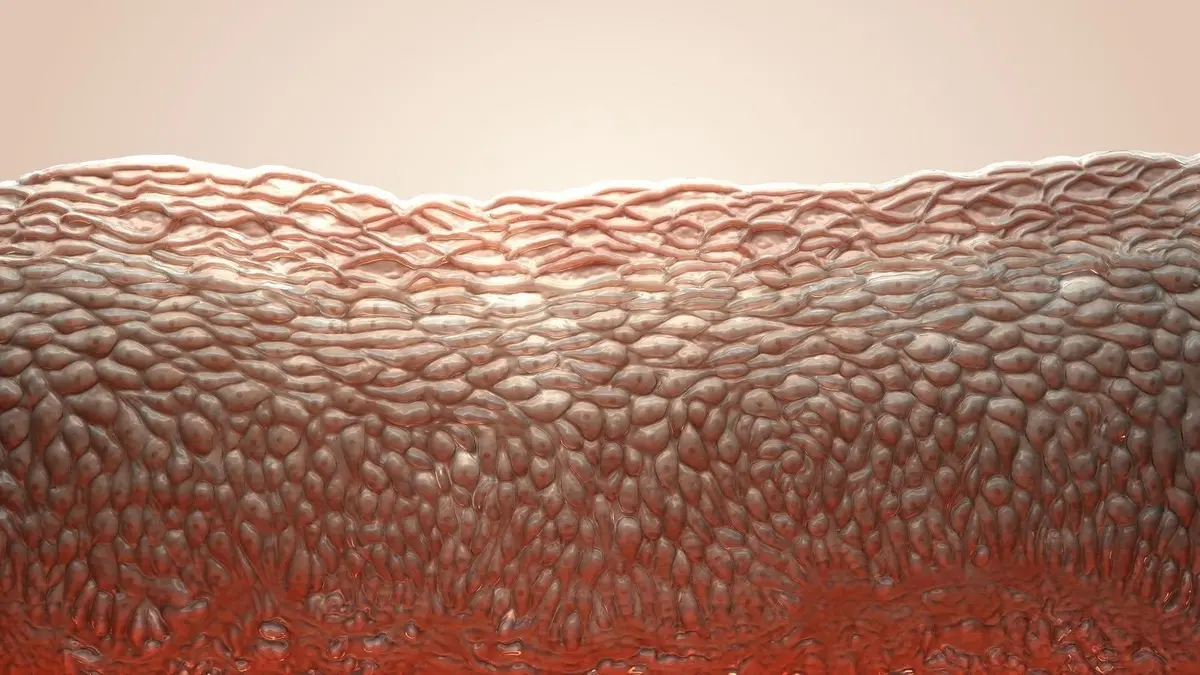
What is enzyme powder? Action and indications
Enzyme powder is a universal product for gentle cleansing and rejuvenating the skin, something between a gel/foam/milk for washing and a maximum gentle and light home peeling.
How does it work?
Our skin must renew itself. In the lower (basal) layer of the epidermis, skin cells – keratinocytes – are produced. These cells gradually rise to the upper (corneal) layer of the epidermis, becoming harder and stiffer along the way. At the end of this process, they transform into corneocytes – dead (keratinized) skin cells on the very surface. Then they are exfoliated, and newly formed cells from below take their place.
In youth, this renewal process takes about 28 days: cells divide quickly due to active metabolic processes. But after the age of 25-30, the skin renewal rate decreases to 30-35 days, and after forty years, it can take 70 days or more.
As a result, dead cells accumulate on the face and cause numerous problems:
- Roughness and dullness. Due to the excess corneocytes on the surface, the skin appears duller and feels rougher. Makeup doesn’t adhere as well to it.
- Black dots and pimples. Dead cells mix with sebum (oil) and dust, clogging the skin pores and creating blackheads. This mixture inside the pores also creates an ideal nutrient environment for bacteria to multiply, resulting in breakouts and inflammation – comedonal acne.
- Milia. Dead cells can also form dense subcutaneous bumps called milia, which are white or grayish in color. They usually appear in areas with thin skin (around the eyes, on the cheeks and temples).
- Pigmented spots. Some corneocytes contain the pigment melanin, which helps protect us from ultraviolet radiation. If these cells are not exfoliated in time and remain on the skin's surface for too long, they form pigmented spots.

And here enzyme powder comes to our aid.
The key ingredient in enzyme powder is enzymes.
In general, enzymes are complex protein compounds that serve as “stimulators” (catalysts) for chemical reactions in our body. Each enzyme is a “narrowly specialized worker”; it stimulates one specific type of reaction. In total, there are more than 3,000 different types of enzymes working in our body.
In enzyme cosmetics, such “special workers” are used: proteases. This type of enzyme dissolves the protein “bridges” (corneodesmosomes) that bind corneocytes to each other and allow them to remain on the skin's surface.

By dissolving these “bridges”, enzyme powder helps gently and carefully accelerate the skin's renewal process. Unlike acids, enzymes only act on the upper layers of the epidermis. Therefore, enzyme powder does not damage dry and sensitive skin and is suitable for all skin types, regardless of oil gland activity.
But that’s not all. Enzyme powder can also have additional properties depending on its composition.
Composition of enzyme powder
Enzymes can be plant-based (derived from plant materials) and bacterial (derived from beneficial bacterial structures). Depending on the type of enzyme in the powder, it may have different additional effects.
- Papain. This enzyme is found in papaya fruit extract. In addition to its main action, it has anti-inflammatory and antibacterial effects, soothing irritated and sensitive skin, and aiding troubled facial skin.
- Bromelain. An enzyme from pineapple extract. It also has anti-inflammatory effects and helps improve microcirculation, making it useful in combating facial puffiness. Additionally, bromelain affects protein components in sebum and aids in its thinning: sebum becomes less thick, making it easier to cleanse clogged pores. Therefore, bromelain is good for oily skin.
- Lipase. This enzyme can be derived from plant sources (wheat, sunflower) as well as microbiological (fungi, bacteria). Like bromelain, it helps thin the sebum and is suitable for cleansing oily skin. It also regulates skin microflora due to its mild antibacterial effect, aiding in the fight against breakouts.
- Amylase. This enzyme can be obtained from fungi and bacteria, as well as from plant sources (sweet potatoes, potatoes, wheat, and corn). In addition to its main action, it removes residues of polysaccharides from the skin. These long chains of sugar molecules form a sticky mixture with sebum and clog pores, hindering proper skin hydration. They often end up on the skin due to external pollution, cosmetic products, and natural metabolic byproducts.
- Superoxide dismutase (SOD). This enzyme is derived from pumpkin extract, as well as from bacteria and fungi. SOD has antioxidant properties — it helps protect skin cells from the effects of free radicals and premature aging. This enzyme also reduces inflammation and stimulates skin regeneration after damage.

In addition to enzymes, other components can also be added to the powder, such as:
- glycine, hyaluronic acid — moisturizing factors that help combat dryness and dehydration of the skin;
- allantoin, rice or corn starch — regulate sebum production, removing excess oil and providing a matte finish to the skin;
- vitamin C, vitamin E, green tea — antioxidants that help protect the skin from aging due to free radicals;
- aloe vera and calendula extracts, tea tree oil — soothing and anti-inflammatory components that help combat increased sensitivity and irritation.
How to use enzyme powder?
- Enzyme powder looks like a fine powder — it needs to be diluted with warm water (NOT hot, at room temperature). We pour the powder into the palm of our hand and rub it with a wet hand until we achieve a uniform mixture.
- Depending on the amount of powder, we can achieve different consistencies and methods of application:
- Less powder (about the size of a 2-ruble coin) — we get a consistency similar to a light milk or gel, which is excellent for cleansing, and keep it on the face for 1 minute.
- More powder (about 3 g, the size of a 5-ruble coin) — we achieve a foamier and thicker consistency, suitable for both washing and a gentle exfoliating mask (leave on for 3-5 minutes).
Enzyme powder can also be used as an exfoliant for the scalp or body.
Now for some important rules of use:
- Be sure to check for allergies before use. The powder may contain plant components with allergy risks. Therefore, after purchase, apply a small amount of powder to the inner bend of the elbow, rub it with a wet hand, leave it for 3-5 minutes, and rinse. If there is no irritation or redness after half an hour to an hour, the powder can be used.
- Introduce gradually into your routine. For the first month, use the powder no more than once a week. After use, we may feel slight tightness — this is normal.
- Do not use too often. If the skin is dry and normal, apply no more than 1-2 times a week. If the skin is oily and combination, it is acceptable to apply 3-4 times a week.
- Make sure to follow up with skincare. After using the powder, wipe the face with toner and apply your usual moisturizing and/or nourishing cream.
- It is also recommended to use enzyme powder in the evening — it stimulates the exfoliation of the stratum corneum, so it may increase photosensitivity. If you prefer to use the powder in the morning, be sure to apply sunscreen with SPF and UVA protection afterward.
Combining enzyme powder with other actives
Enzyme powder works well with peptide serums and niacinamide in skincare.
However, it should not be used simultaneously with other actives that have a peeling effect: BHA and AHA acids, retinol. If you want to use both the powder and these components, apply them at different times of the day (morning/evening).
Who should not use enzyme powder?
Enzyme powder has its own contraindications.
- Active inflammation and damage. Enzyme powder is useful in the fight against acne, but it is not recommended to apply it during active pustular breakouts. The same applies to active skin damage (burns, scratches, and other wounds), dermatitis, eczema, and other skin diseases in the acute phase.
- Skin after barrier damage. Enzyme powder should also not be used for 2-3 weeks after procedures that damage the protective hydrolipid barrier (mechanical and acid peels, laser resurfacing, etc.).
- Active peeling. Enzyme powder is needed to start the natural skin renewal processes. If the skin is already actively peeling (for example, after sun exposure or peeling procedures), it is not advisable to apply enzyme powder.
Enzyme powder and enzyme peeling — what’s the difference?
Although powder and enzyme peeling have the same mechanism of action on the skin, there is a difference — the purpose of application:
- Enzyme powder is the lightest and gentlest means for home skincare.
- Enzyme peeling is already a complete procedure for deeper (but still gentle) skin cleansing, which takes from 5 to 20 minutes.